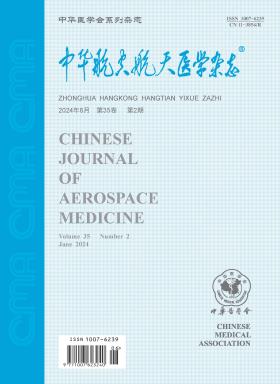Three cases of flying personnel with apical hypertrophy cardiomyopathy and literature review
引用次数: 0
Abstract
Objective To discuss the influence of apical hypertrophy cardiomyopathy (AHCM) on the flying personnel's and the evaluation principle of aeromedicine. Methods The clinical AHCM data, including diagnosis, therapy and prognosis of three pilots were analyzed and related literatures were reviewed. Results Three flying personnel cases were without clinical symptoms but were diagnosed as AHCM according to abnormal electrocardiogram and echocardiogram in physical examination. In 24-year follow-up of case 1 the ECG showed T wave inversion upon V3, V4 leads and the amplitude raised from 0.4 mV to 0.9 mV, the thickness of apex cordis increased from 12 mm to 19 mm. But he had safe flight for 19 000 h. Case 2 showed T wave inversion upon V3-V5 leads and the amplitude changed from 0.5 mV to 1.4 mV, the thickness of apex cordis varied from 12 mm to 24 mm in 22-year follow-up. He had safe flight for 20 000 h. Nine-year follow-up was taken for case 3 that also appeared T wave inversion on V5 lead, amplitude changed from 0.2 mV to 0.6 mV and the thickness of apex cordis increased from 12 mm to 17 mm. He had safe flight for 1 000 h. Conclusions Early diagnosis of AHCM will benefit to take the clinical follow-up for flying personnel. Due to the good prognosis the qualification could be issued to the flying personnel with AHCM but must be with strict supervision. The individual evaluation is also suggested. Key words: Cardiomyopathy, hypertrophic; Eligibility determination; Rstricted flying; Aircrews飞行人员心尖肥厚性心肌病3例并文献复习
目的探讨心尖肥厚性心肌病(AHCM)对飞行人员的影响及航空医学评价原则。方法对3名飞行员的AHCM临床资料进行分析,包括诊断、治疗和预后,并复习相关文献。结果3例飞行人员无临床症状,体检时根据异常心电图和超声心动图诊断为AHCM。病例1随访24年,心电图显示V3、V4导联T波反转,幅度由0.4 mV增加到0.9 mV,心尖厚度由12 mm增加到19 mm。在22年的随访中,病例2表现为V3-V5导联T波反转,振幅从0.5 mV变化到1.4 mV,心尖厚度从12 mm变化到24 mm。病例3随访9年,V5导联也出现T波反转,振幅由0.2 mV变化至0.6 mV,心尖厚度由12 mm增加至17 mm。结论AHCM的早期诊断有利于对飞行人员进行临床随访。由于预后良好,AHCM飞行人员可以获得资格,但必须受到严格的监督。建议进行个人评价。关键词:心肌病;肥厚;资格审定;Rstricted飞行;机组人员
本文章由计算机程序翻译,如有差异,请以英文原文为准。
求助全文
约1分钟内获得全文
求助全文
来源期刊

中华航空航天医学杂志
航空航天医学
自引率
0.00%
发文量
2962
期刊介绍:
The aim of Chinese Journal of Aerospace Medicine is to combine theory and practice, improve and popularize, actively advocate a hundred flowers bloom and a hundred schools of thought contend, advocate seeking truth from facts, promote the development of the related disciplines of aerospace medicine and human efficiency, and promote the exchange and penetration of aerospace medicine and human efficiency with other biomedical and engineering specialties.
Topics of interest for Chinese Journal of Aerospace Medicine include:
-The content of the journal belongs to the discipline of special medicine and military medicine, with the characteristics of multidisciplinary synthesis and cross-penetration, and mainly reflected in the aerospace industry, aerospace flight safety and efficiency, as well as the synthesis of special medicine, preventive medicine, environmental medicine, psychology, etc.
-Military aeromedicine (Air Force, Navy and Army aeromedicine) and civil aeromedicine, with a balance of aerospace medicine are the strengths of the journal.
-The change in aerospace medicine from a focus on promoting physiological compensatory adaptations to enhancing human performance under extreme environmental conditions is what the journal is helping to promote.
-The expansion of manuscripts in high altitude medicine is also a special emphasis of the journal.
 求助内容:
求助内容: 应助结果提醒方式:
应助结果提醒方式:


